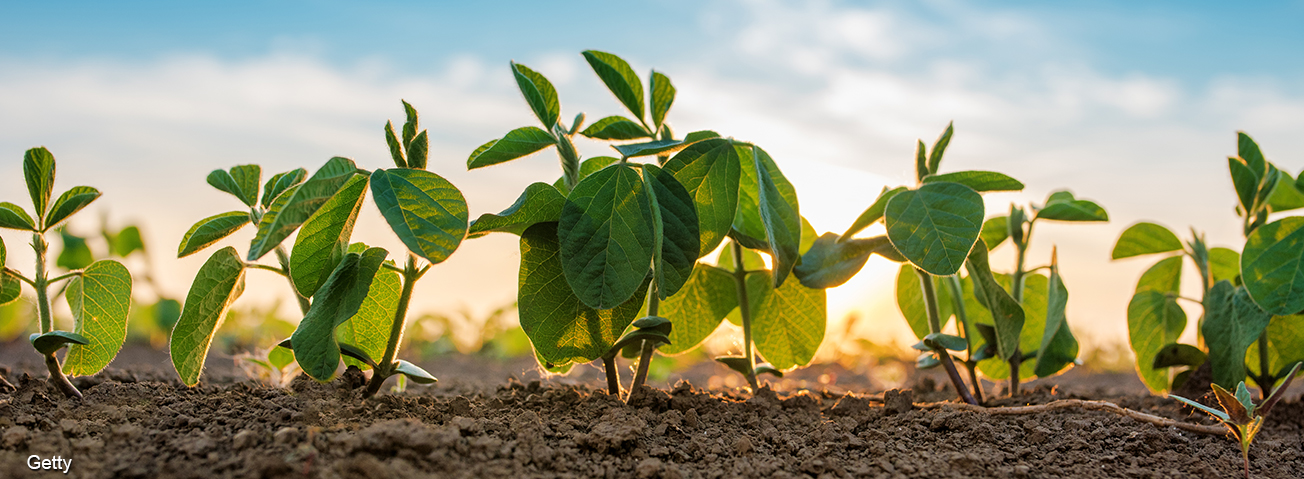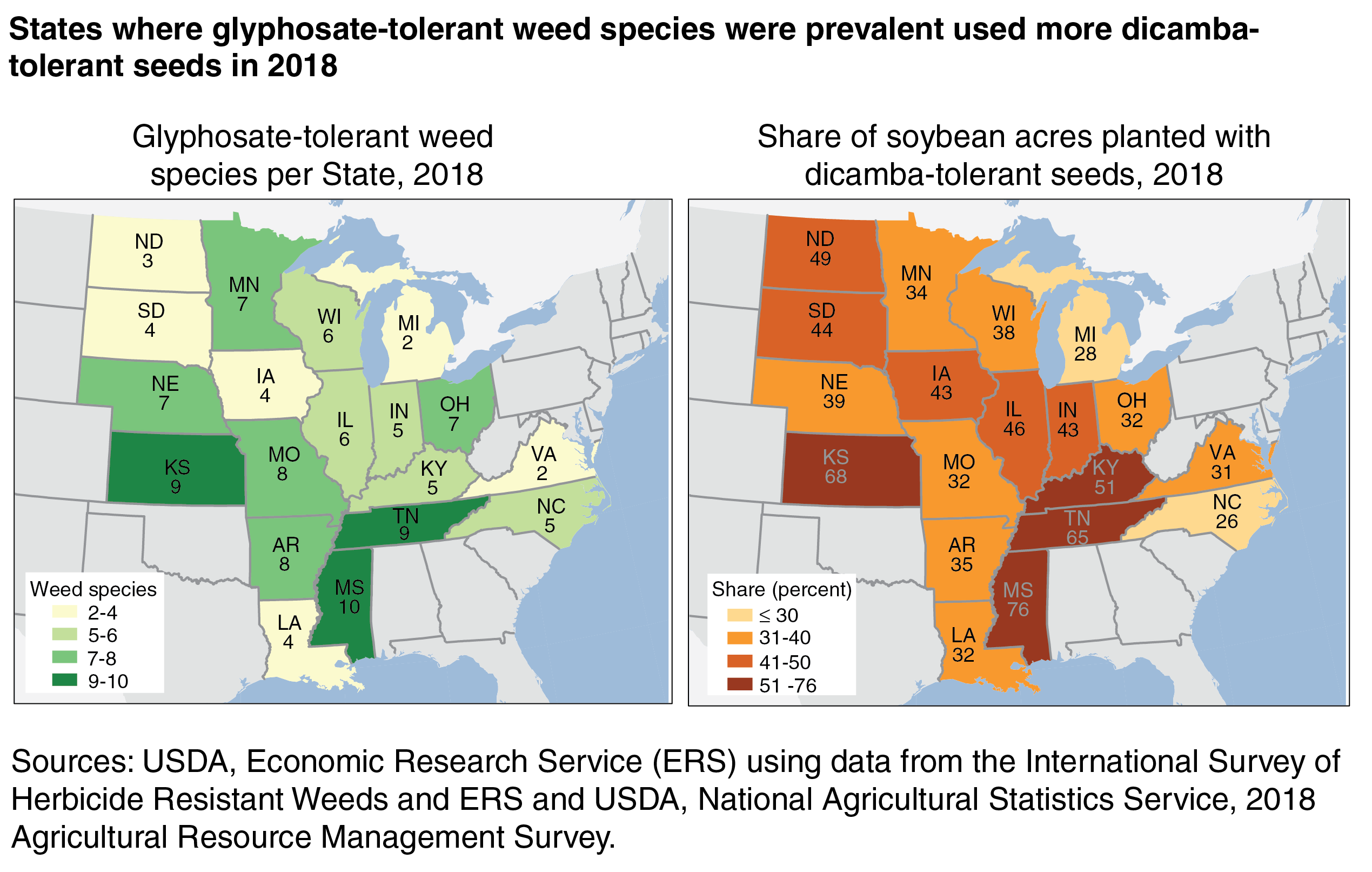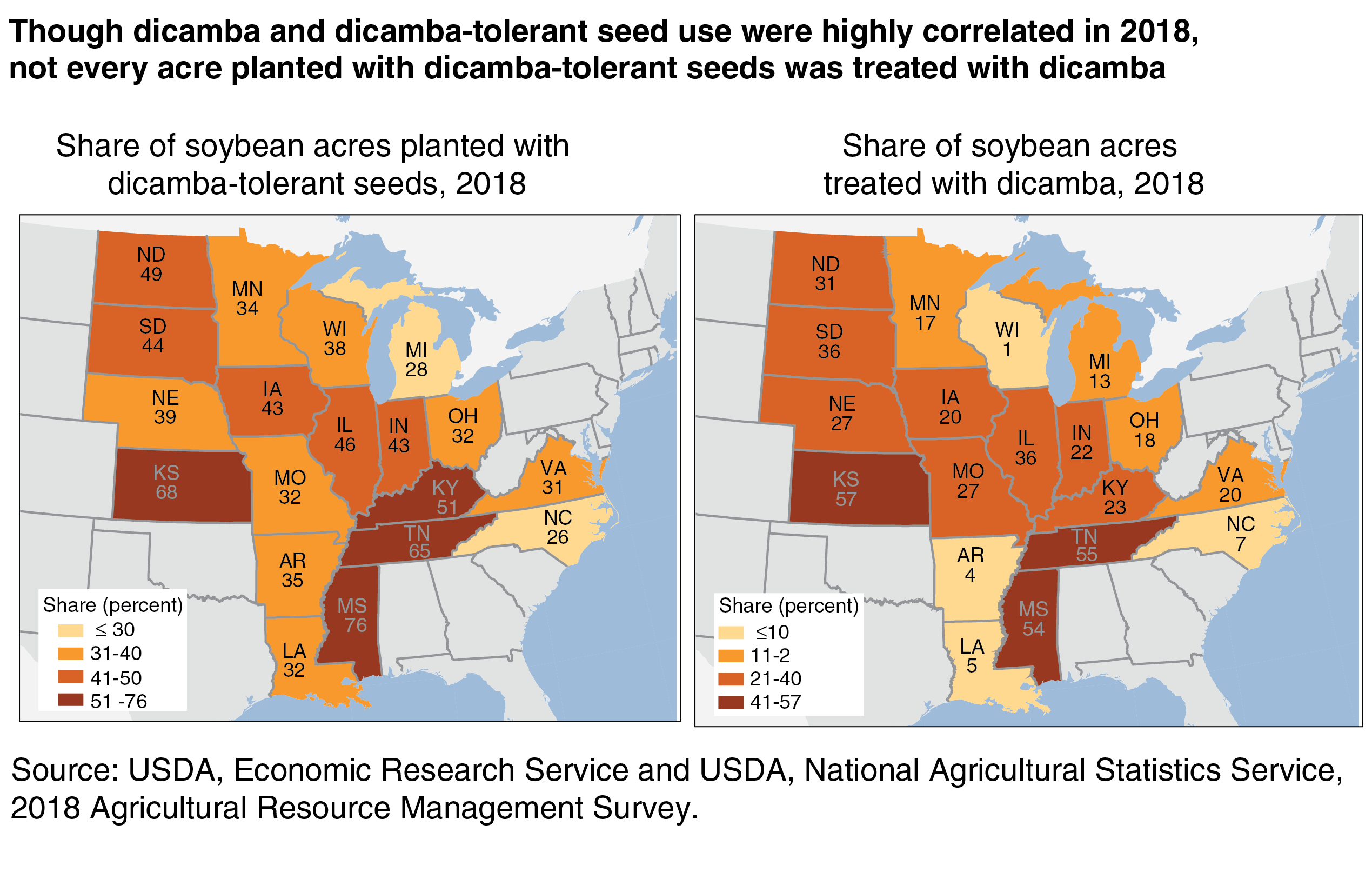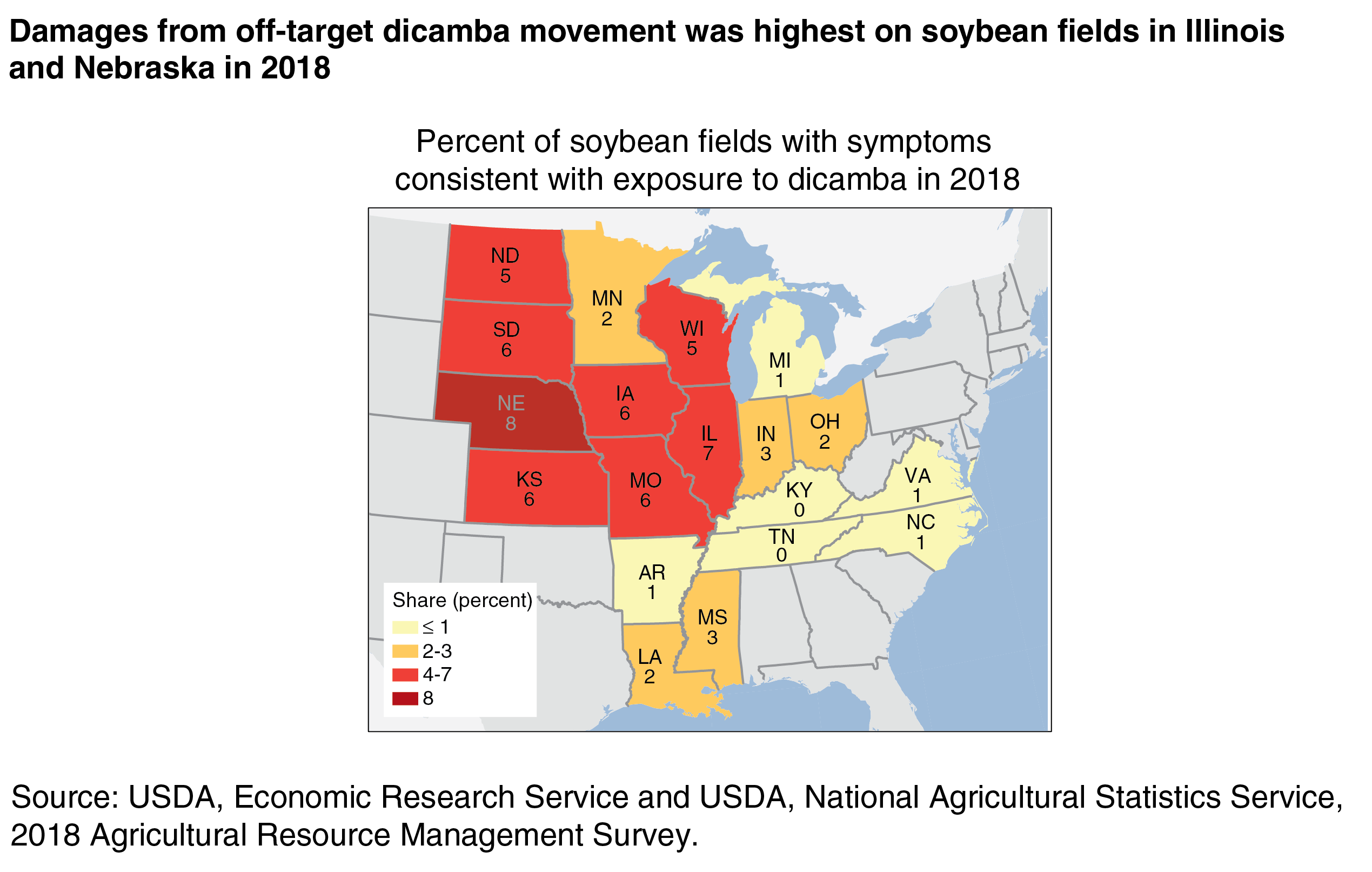
The Use of Genetically Engineered Dicamba-Tolerant Soybean Seeds Has Increased Quickly, Benefiting Adopters but Damaging Crops in Some Fields
- by Seth J. Wechsler, David Smith, Jonathan McFadden, Laura Dodson and Sam Williamson
- 10/1/2019
Highlights
- The share of soybean acreage planted with dicamba-tolerant seeds increased by 43 percent from 2016 (when these seeds were commercialized) to 2018.
- There was more dicamba-tolerant seed use in States where glyphosate-resistant weed species were prevalent.
- Approximately 4 percent of soybean fields were damaged by off-target movement of dicamba in 2018.
Weeds can cause serious problems for U.S. soybean producers. Left untreated, severe weed infestations can reduce soybean yields by more than 50 percent. Most soybean producers achieve high levels of weed control using modern synthetic herbicides. However, there are risks associated with herbicide use. For instance, herbicides that are improperly applied can move off-target, potentially damaging crops that are on or near the field where the herbicides were applied.
Glyphosate is a broad-spectrum herbicide that kills most broad-leaf weeds and grasses. Before genetically engineered glyphosate-tolerant soybeans were commercialized in 1996, glyphosate was used infrequently in soybean production. When glyphosate was used, it tended to be applied early in the growing season, before soybean seedlings had emerged from the soil. Glyphosate could be applied late in the growing season, but the use of specialized equipment (like hooded sprayers) did not eliminate the possibility of damage from off-target glyphosate movement.
The commercialization of glyphosate-tolerant soybeans practically removed the possibility of damage from late season glyphosate use. Glyphosate-tolerant soybean and glyphosate use increased rapidly in the years that followed. By 1998, more than 4 out of every 10 soybean acres were planted with glyphosate-tolerant seeds. By 2006, almost 9 out of every 10 acres were planted with glyphosate-tolerant seeds.
As glyphosate-tolerant seed use became more common, an increasing number of farmers started using glyphosate, and only glyphosate, for weed control in soybeans. On some fields, a small number of naturally resistant weeds, from a small number of weed species, survived (or “escaped”) glyphosate applications. Over time, these weeds bred and spread, passing on their natural resistance to the next generation. By 2018, there were glyphosate-tolerant weeds in the majority of soybean-producing States. Glyphosate resistance appears to be particularly problematic in States located southwest of the Corn Belt—such as Mississippi, Kansas, Tennessee, Arkansas, and Missouri—where the most glyphosate-tolerant weed species are present.
One way to control glyphosate-tolerant weeds is to treat them with herbicides other than glyphosate, such as dicamba or 2,4-D choline. Chemical and seed companies have recently developed new soybean varieties that are tolerant of these herbicides. For instance, Xtend soybeans, which are tolerant of dicamba, were commercialized in 2016. Enlist soybeans, which are tolerant of 2,4-D choline, were commercialized prior to the 2019 growing season.
Farmers’ responses to the Soybean Production Practices and Costs Report (commonly referred to as Phase II of the Agricultural Resource Management Survey) for 2018 suggest that approximately 43 percent of U.S. soybean acreage was planted with dicamba-tolerant seeds in 2018. The increase in dicamba-tolerant seed use from 2016 to 2018 is similar to the rate at which soybean farmers adopted glyphosate-tolerant varieties in the years immediately following their commercial introduction, from 1996 to 1998. The States with the most dicamba-tolerant seed use in 2018 were Mississippi, Tennessee, and Kansas—where approximately 79 percent, 71 percent, and 69 percent of soybean acreage was planted with these varieties (respectively). Notably, there appears to be more dicamba-tolerant seed use in the States with the most glyphosate-tolerant weeds.
Not all acres planted with dicamba-tolerant soybeans are treated with dicamba. In all 19 States studied, more acres were planted with dicamba-tolerant seed than were actually sprayed with dicamba. For instance, in Mississippi, 79 percent of soybean acres were planted with dicamba-tolerant seeds, but only 54 percent of these acres were treated with dicamba. In some cases, farmers may only use dicamba if glyphosate-tolerant weeds appear. In other cases, dicamba-tolerant seeds might be planted to prevent yield losses from unintended exposure to dicamba.
Off-target movement of dicamba can damage other plants—particularly non-dicamba-tolerant soybeans, which are highly susceptible to dicamba, even at very low doses. This movement generally occurs when droplets of dicamba “drift” at ground level during application, or when dicamba vaporizes after application, rises into the atmosphere, and floats hundreds to thousands of feet downwind. In some cases, off-target movement also occurs because spray equipment is not thoroughly cleaned following a dicamba application, and small quantities of dicamba are inadvertently mixed with other herbicides.
Farmers’ responses to USDA’s Soybean Production Practices and Costs Report for 2018 suggest that approximately 4 percent of soybean fields were damaged by off-target dicamba movement in 2018. The largest share of fields was damaged in Nebraska and Illinois, where damage from dicamba was reported on approximately 1 in every 13 fields.
Some of the States with the least damage to soybeans were also the States where the most dicamba was sprayed. For instance, though over half of soybean fields in Mississippi were treated with dicamba, only 3 percent of soybean fields were damaged by off-target dicamba movement in 2018. Largely, this is because 73 percent of the soybeans planted in Mississippi were dicamba-tolerant. However, Federal and State-level restrictions on dicamba use may also have played a role in reducing damages.
In 2018, dicamba use was governed by Federal label rate restrictions, which mandated that:
- Dicamba be classified as a restricted-use pesticide (a designation that prohibits anyone but certified applicators from purchasing or applying dicamba products);
- Licensed applicators complete dicamba-specific training;
- Dicamba be applied when wind speeds are 10 mph and below;
- Dicamba not be applied when the wind is blowing toward crops that are susceptible to dicamba (such as specialty crops or non-dicamba-tolerant soybean varieties);
- Dicamba be applied between sunrise and sunset;
- Spray equipment be thoroughly cleaned before and after dicamba applications;
- Detailed records be made following each dicamba application.
Certain States, including Arkansas, Louisiana, Minnesota, Missouri, North Dakota, and Tennessee, imposed additional restrictions on dicamba use in 2018. In Arkansas, Louisiana, Minnesota, Missouri, and North Dakota, dicamba could only be applied to soybeans early in the growing season—when temperatures are relatively low and some of the risks associated with off-target movement are reduced. In Missouri, North Dakota, and Tennessee, dicamba use was restricted to times of day when dicamba is less likely to drift.
| Dicamba cannot be applied: | |||
|---|---|---|---|
| Later than… | If temperature is over… | Unless the time is between… | |
| Arkansas | April 161 | ||
| Louisiana | June 152 | ||
| Minnesota | June 20 | 85°F | |
| Missouri | June 101; July 15 | 7:30 a.m. and 5:30 p.m. | |
| North Dakota | June 30 | 85°F | 1 hour after sunrise and 1 hour before sunset |
| Tennessee3 | 7:30 a.m. and 5:30 p.m. | ||
| Note: 1Pastures, rangeland, turf, ornamental, direct injection for forestry, and home use are exempt. 2Cutoff date applies to select geographic locations. 3Older formulations of dicamba are banned. Source: USDA, Economic Research Service using data from State departments of agriculture. |
|||
Other States—including Indiana, Iowa, and Mississippi—did not impose restrictions on the timing of dicamba applications, but did mandate that applicators attend State-approved training and maintain detailed recordkeeping.
There is not an easily identifiable geographic pattern between the presence of regulations and the fraction of damaged soybean acreage. Some States with relatively high rates of damage (such as Iowa and North Dakota) had State-level regulations, while others (such as Wisconsin) did not. This may be because States with high levels of damage are more likely to impose regulations. It may also be because dicamba-based products are used for weed control in crops other than soybeans, and many of these products are not subject to the State-level restrictions listed in Table 1.
Controlling weed resistance to herbicides is a constant challenge. ERS economists are currently studying how recently commercialized genetically engineered herbicide-tolerant soybean varieties affect soybean farmers’ profits and input costs, the development of weed resistance, and the costs of damages associated with off-target herbicide movement. Until new herbicidal modes of action are developed, or paradigm-shifting weed control technologies are commercialized, genetically engineered herbicide-tolerant varieties are likely to continue playing an important role in domestic field crop production.
This article is drawn from:
- Wechsler, S.J. (2018, December 3). Trends in the Adoption of Genetically Engineered Corn, Cotton, and Soybeans. Amber Waves, U.S. Department of Agriculture, Economic Research Service.
- Adoption of Genetically Engineered Crops in the United States. (n.d.). U.S. Department of Agriculture, Economic Research Service.
- Livingston, M., Fernandez-Cornejo, J., Unger, J., Osteen, C., Schimmelpfennig, D., Park, T. & Lambert, D. (2015). The Economics of Glyphosate Resistance Management in Corn and Soybean Production. U.S. Department of Agriculture, Economic Research Service. ERR-184.
- Wechsler, S., J. McFadden, and D. Smith. “What do farmers’ weed control decisions imply about glyphosate resistance? Evidence from surveys of US corn fields. (2017). Pest Management Science, 74(5): 1143-1154.
- Bradley, Kevin. “Ag Industry, Do We Have a Problem Yet?. (2017). Integrated Pest Management, University of Missouri.
- Bradley, Kevin. 2018. “July 15 Dicamba injury update. Different year, same questions.” . (2018). Integrated Pest Management, University of Missouri.
- Heap, I. . (2019). The International Survey of Herbicide Resistant Weeds. .
You may also like:
- Fernandez-Cornejo, J., Wechsler, S.J., Livingston, M. & Mitchell, L. (2014). Genetically Engineered Crops in the United States. U.S. Department of Agriculture, Economic Research Service. ERR-162.
- Nehring, R., Osteen, C., Wechsler, S.J., Martin, A., Vialou, A. & Fernandez-Cornejo, J. (2014). Pesticide Use in U.S. Agriculture: 21 Selected Crops, 1960-2008. U.S. Department of Agriculture, Economic Research Service. EIB-124.




